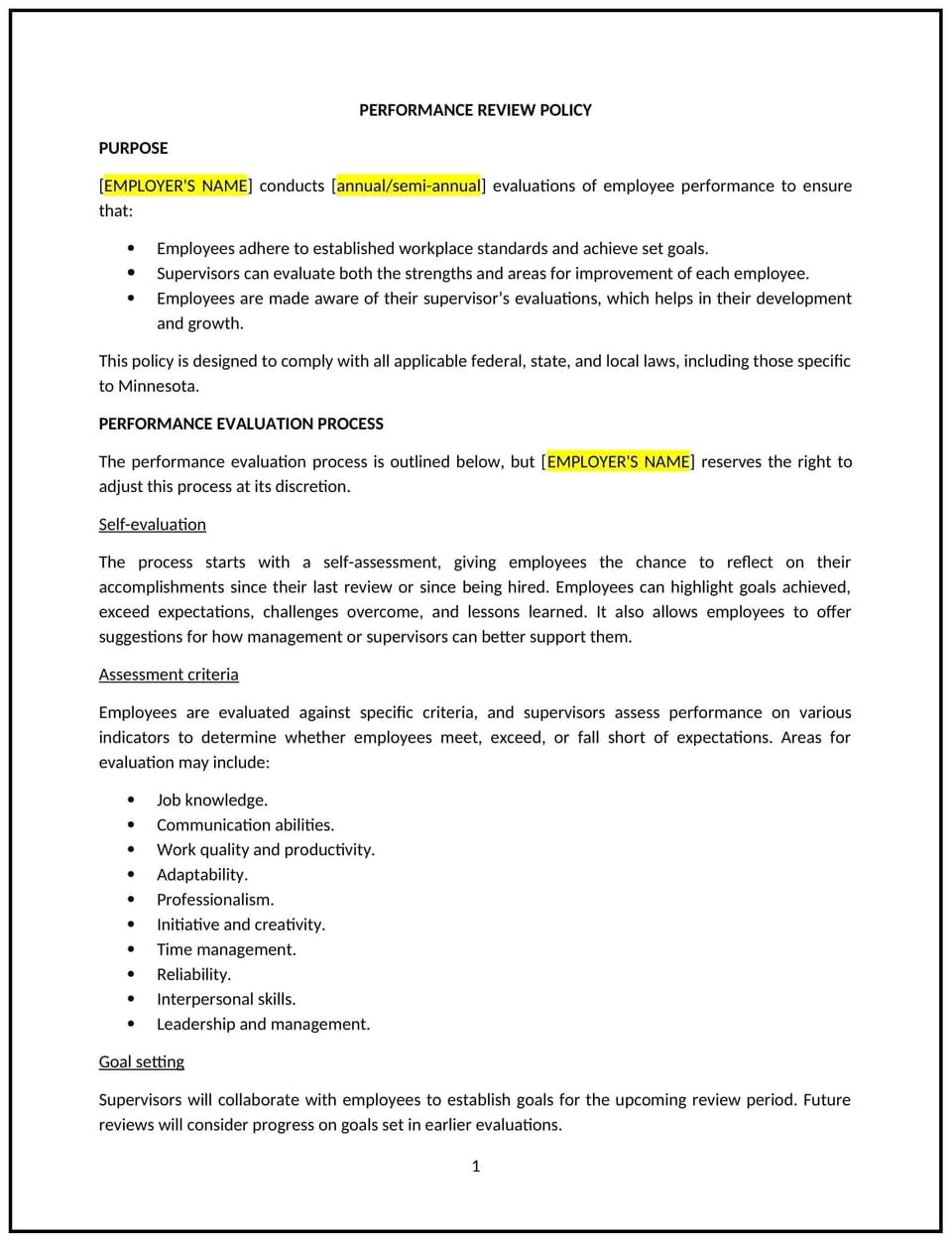Performance review policy (Minnesota): Free template

Performance review policy (Minnesota)
This performance review policy is designed to help Minnesota businesses establish a clear, structured process for evaluating employee performance. It outlines how performance reviews will be conducted, the criteria used for evaluations, and how feedback will be provided to employees. The policy emphasizes the importance of ongoing development, goal setting, and performance improvement.
By implementing this policy, businesses can foster a culture of continuous improvement, enhance employee engagement, and ensure alignment between individual performance and company objectives.
How to use this performance review policy (Minnesota)
- Define performance expectations: Clearly outline the key performance indicators (KPIs) and expectations for each role within the company. This ensures that employees understand what is expected of them and how their performance will be measured.
- Establish review frequency: Specify how often performance reviews will take place (e.g., annually, semi-annually, or quarterly) and the timeline for providing feedback.
- Set clear criteria for evaluation: Establish clear and objective criteria for evaluating performance, such as work quality, productivity, teamwork, adherence to company values, and personal development.
- Use a standardized format: Create a standardized format for conducting performance reviews, ensuring consistency across departments and roles. This could include a combination of self-assessments, manager assessments, and peer feedback.
- Provide constructive feedback: Ensure that feedback is constructive, specific, and actionable, focusing on both strengths and areas for improvement. Managers should set clear goals for employees and offer support for skill development and performance enhancement.
- Set goals for development: Include the setting of individual goals for employees during the performance review process. These goals should align with both personal development and organizational objectives.
- Address compensation and promotions: Include discussions of compensation adjustments, promotions, or bonuses as part of the performance review process, based on the outcomes of the evaluation and business needs.
Benefits of using a performance review policy (Minnesota)
Implementing this policy provides several advantages for Minnesota businesses:
- Promotes alignment: By clearly defining performance expectations and goals, businesses can ensure that employees are aligned with the company’s strategic objectives, leading to improved performance across the organization.
- Encourages professional development: Regular performance reviews allow employees to receive feedback on their strengths and areas for improvement, fostering personal and professional growth.
- Enhances employee engagement: Employees who receive regular feedback and understand their performance goals are more likely to feel engaged, motivated, and valued within the company.
- Reduces turnover: Transparent performance management can help identify employees who may be at risk of leaving the company, allowing managers to address issues before they lead to turnover.
- Reflects Minnesota-specific considerations: Tailors the policy to Minnesota’s work culture, addressing local workforce expectations and ensuring compliance with state labor laws regarding performance evaluations and compensation.
Tips for using this performance review policy (Minnesota)
- Communicate clearly: Ensure that employees are informed about the performance review process and the criteria on which they will be evaluated. This helps set expectations and reduces confusion.
- Provide regular feedback: Performance reviews should not be the only time employees receive feedback. Managers should provide ongoing, real-time feedback to help employees improve throughout the year.
- Set SMART goals: Encourage employees to set SMART (Specific, Measurable, Achievable, Relevant, and Time-bound) goals during their performance reviews to guide their development and provide clarity on expectations.
- Foster an open dialogue: Create a culture where employees feel comfortable discussing their performance openly, asking questions, and seeking clarification on feedback.
- Review regularly: The policy should be reviewed periodically to ensure that it remains aligned with evolving business objectives, employee needs, and any changes to Minnesota labor laws.
Q: How often should performance reviews be conducted?
A: Businesses should determine the frequency of performance reviews based on their needs. Common review schedules are annual, semi-annual, or quarterly. Regular reviews help employees stay on track and receive timely feedback.
Q: What criteria are used to evaluate employee performance?
A: Businesses should establish clear, objective criteria for evaluating performance, which may include job knowledge, work quality, productivity, teamwork, initiative, communication, and adherence to company values.
Q: Are employees involved in their performance review?
A: Yes, businesses should encourage employees to be involved in the review process. This can include self-assessments and goal setting, allowing employees to reflect on their own performance and contribute to discussions about their development.
Q: How can feedback be made constructive?
A: Feedback should be specific, clear, and focused on actions and outcomes. Instead of just identifying problems, managers should provide actionable solutions and support to help employees improve.
Q: Can performance reviews affect compensation or promotions?
A: Yes, businesses should use performance reviews as a basis for determining salary increases, bonuses, and promotions, in alignment with employee performance and business goals. The policy should outline how compensation is tied to performance outcomes.
Q: What if an employee disagrees with their performance review?
A: Businesses should provide a clear process for employees to voice concerns or disputes about their performance review. This can include a follow-up meeting with the manager or HR to discuss the feedback and clarify expectations.
Q: How should businesses handle underperformance in performance reviews?
A: Underperformance should be addressed with clear, constructive feedback. Businesses should work with the employee to develop an action plan for improvement, which may include additional training, mentoring, or support.
Q: How often should this policy be reviewed?
A: The policy should be reviewed annually or whenever there are significant changes in company goals, employee performance needs, or Minnesota state labor laws to ensure it remains effective and aligned with the organization’s objectives.
This article contains general legal information and does not contain legal advice. Cobrief is not a law firm or a substitute for an attorney or law firm. The law is complex and changes often. For legal advice, please ask a lawyer.


